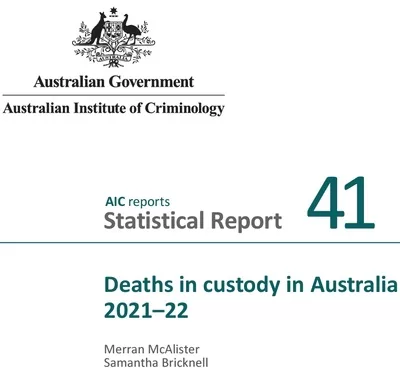In 2021–22 there were 106 deaths in custody, 23 more than in 2020–21. The total included 24 Indigenous deaths and 81 non-Indigenous deaths. The Indigenous status of one deceased was unknown.
Since the Royal Commission into Aboriginal Deaths in Custody in 1991, the National Deaths in Custody Program has recorded 516 Indigenous deaths in custody, including 335 in prison, 177 in police custody or custody-related operations and four in youth detention.
In this period 84 of those deaths were in prison custody. Sixteen of these were of Indigenous people and 68 were of non-Indigenous people. The other 22 deaths were within police custody. Eight of these were of Indigenous people and 13 were of non-Indigenous people.
Indigenous people were less likely than non-Indigenous people to die as a proportion of the relevant prisoner population but more likely to die as a proportion of the relevant general population.
Natural causes and hanging deaths were the most common causes of death for Indigenous deaths in prison custody in 2021–22. Most non-Indigenous deaths in prison custody were due to natural causes.
The Australian Institute of Criminology (AIC) latest statistical report from the National Deaths in Custody Program (NDICP) “Deaths in custody in Australia 2021–22″ report is available on the AIC website.
Deputy Director of the AIC, Dr Rick Brown said Deaths in custody in Australia 2021–22 provides timely statistics on deaths in custody for the previous financial year and trend data on deaths in custody since 1979–80. The annual report complements the AIC’s Deaths in custody in Australia quarterly dashboard which publishes quarterly updates on deaths in prison and police custody.
“The AIC is committed to criminological research into Indigenous over-representation in the criminal justice system, including the delivery of the Indigenous Justice Research Program.
“In 2023, the AIC will also manage the Indigenous Justice Clearinghouse which aims to promote discussion and disseminate relevant Indigenous justice information to government policy makers and those working in the Indigenous justice field,” Dr Brown said.
The final report of the RCIADIC (1991, recommendation 41) outlined the types of deaths that would require notification to the NDICP. They are:
• a death, wherever occurring, of a person who is in prison custody, police custody or youth detention;
• a death, wherever occurring, of a person whose death is caused or contributed to by traumatic injuries sustained, or by lack of proper care, while in such custody or detention;
• a death, wherever occurring, of a person who dies, or is fatally injured, in the process of police or prison officers attempting to detain that person; or
• a death, wherever occurring, of a person attempting to escape from prison, police custody or youth detention.
In 1991, the RCIADIC concluded that Indigenous people were no more likely to die in custody than non-Indigenous people, but were significantly more likely to be arrested and imprisoned. The same remains true today.
In the 31 years since the RCIADIC (1991), the NDICP has recorded 516 Indigenous deaths in custody (ie prison custody, police custody and custody-related operations and youth justice)
“The AIC has continued to collaborate with the NDICP Steering Group to ensure we provide the most accurate information as timely as possible.
“We gratefully acknowledge the ongoing assistance of each of Australia’s police services, corrections departments and youth justice authorities in supplying the information that forms the basis of this report,” Dr Brown said.
Background notes
The NDICP is compiled from two main data sources:
- NDICP data collection forms completed by all state and territory police services and correctional departments in Australia.
- Coronial records, including transcripts of proceedings and findings, as well as toxicology and post-mortem reports, drawn from the National Coronial Information System.
The information presented in the report is quantitative and intended to provide an overview of statistical trends and patterns. It does not provide information on individual cases, or information of a more qualitative nature.




